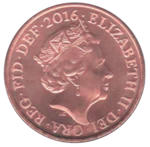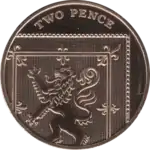Two pence (British decimal coin)
The British decimal two pence coin (often shortened to 2p in writing and speech) is a denomination of sterling coinage equalling 2⁄100 of a pound. Since the coin's introduction on 15 February 1971, the year British currency was decimalised, its obverse has featured four profiles of Queen Elizabeth II.[1] In 2008 the design on its reverse changed from the original depiction of a plume of ostrich feathers with a coronet to a segment of the Royal Shield.
United Kingdom (UK) | |
| Value | £0.02 |
|---|---|
| Mass | 7.12 g |
| Diameter | 25.9 mm |
| Thickness | |
| Edge | Plain |
| Composition |
|
| Years of minting | 1971–present |
| Obverse | |
 | |
| Design | Queen Elizabeth II |
| Designer | Jody Clark |
| Design date | 2015 |
| Reverse | |
 | |
| Design | Segment of the Royal Shield |
| Designer | Matthew Dent |
| Design date | 2008 |
The two pence coin was originally minted from bronze, but changed in 1992 to copper-plated steel.
As of March 2014 there were an estimated 6.55 billion 2p coins in circulation corresponding to a value of £131 million.[2]
Two pence coins are legal tender for amounts only up to the sum of 20p when offered in repayment of a debt; however, the coin's legal tender status is not normally relevant for everyday transactions.
Composition
From its first minting in 1971 until 1992, two pence coins were made from bronze. In 1992, this was changed to copper-plated steel because of the increasing price of copper used to make bronze.[3] Both the bronze and steel versions were made in 1992 only.
By May 2006 the pre-1992 (97% copper) coins contained 3p worth of copper each.[4] In May 2006, about 2.55 billion such coins remained in circulation,[4] and the Royal Mint warned that tampering with coinage is illegal in the UK.[5] During 2008, the value of copper fell dramatically from these peaks.[6]
Design

Reverse
The original reverse of the coin, designed by Christopher Ironside, and used from 1971 to 2008, is the Badge of the Prince of Wales: a plume of ostrich feathers within a coronet, above the German motto ICH DIEN ("I serve"). The numeral "2" is written below the badge, and either NEW PENCE (1971–1981) or TWO PENCE (from 1982) is written above. A small number of 1983 mintage coins exist with the "New Pence" wording. It was originally planned that an alternative version of the 2p would be minted with a design representing Northern Ireland;[7] these plans never came to fruition. The same design was also re-cut in 1993 producing two minor varieties for that year.[8]
In August 2005 the Royal Mint launched a competition to find new reverse designs for all circulating coins apart from the £2 coin.[9] The winner, announced in April 2008, was Matthew Dent, whose designs were gradually introduced into the circulating British coinage from mid-2008.[10] The designs for the 1p, 2p, 5p, 10p, 20p and 50p coins depict sections of the Royal Shield that form the whole shield when placed together. The shield in its entirety was featured on the now-obsolete round £1 coin. The re-designed 2p coin depicts the second quarter of the shield, showing the Lion Rampant from the Royal Banner of Scotland, with the words TWO PENCE above.
The beading was removed from both sides of the coin in the 2008 re-design.
In October 2023 the King Charles III two-pence coin was presented; the coin features a red squirrel. [11][12]
Obverse
To date, five different obverses have been used: four different portraits and the removal of the beaded border in 2008.[8] In all cases, the inscription is ELIZABETH II D.G.REG.F.D. 2013,[8] where 2013 is replaced by the year of minting. In the original design both sides of the coin are encircled by dots, a common feature on coins, known as beading.
Four different portraits of the Queen have been used on the coin:
- As with all new decimal currency, until 1984 the portrait of Queen Elizabeth II by Arnold Machin appeared on the obverse,[13] in which the Queen wears the 'Girls of Great Britain and Ireland' Tiara.
- Between 1985 and 1997 the portrait by Raphael Maklouf was used,[13] in which the Queen wears the George IV State Diadem. In 1992 the metal used in minting this coin was switched from bronze to copper-plated steel, with a single year of using both alloys in 1998.[3]
- From 1998 to 2015 the portrait by Ian Rank-Broadley was used,[13] again featuring the tiara, with a signature-mark IRB below the portrait.
- As of June 2015, coins bearing the portrait by Jody Clark have been seen in circulation.
Status as legal tender
2p coins are legal tender for amounts up to and including 20 pence.[14][15] However, in the UK, "legal tender" has a very specific and narrow meaning which relates only to the repayment of debt to a creditor, not to everyday shopping or other transactions.[16] Specifically, coins of particular denominations are said to be "legal tender" when a creditor must by law accept them in redemption of a debt.[17] The term does not mean - as is often thought - that a shopkeeper has to accept a particular type of currency in payment.[16] A shopkeeper is under no obligation to accept any specific type of payment, whether legal tender or not; conversely they have the discretion to accept any payment type they wish.[15]
Mintages
| Year | Number minted | Composition | Portrait | Reverse |
|---|---|---|---|---|
| 1971 | 1,454,856,250 | Bronze | Machin | Ironside |
| 1972 | In sets only | |||
| 1973 | In sets only | |||
| 1974 | In sets only | |||
| 1975 | 145,545,000 | |||
| 1976 | 181,379,000 | |||
| 1977 | 109,281,000 | |||
| 1978 | 189,658,000 | |||
| 1979 | 260,200,000 | |||
| 1980 | 408,527,000 | |||
| 1981 | 353,191,000 | |||
| 1982 | In sets only | |||
| 1983 | In sets only | |||
| 1984 | In sets only | |||
| 1985 | 107,113,000 | Maklouf | ||
| 1986 | 168,967,500 | |||
| 1987 | 218,100,750 | |||
| 1988 | 419,889,000 | |||
| 1989 | 359,226,000 | |||
| 1990 | 204,499,700 | |||
| 1991 | 86,625,250 | |||
| 1992 | 102,247,000 | |||
| 1993 | 235,674,000 | |||
| 1994 | 531,628,000 | |||
| 1995 | 124,482,000 | |||
| 1996 | 296,278,000 | |||
| 1997 | 496,116,000 | |||
| 1998 | 98,676,000 | Rank-Broadley | ||
| 115,154,000 | Copper-plated steel | |||
| 1999 | 353,816,000 | |||
| 2000 | 563,659,000 | |||
| 2001 | 551,880,000 | |||
| 2002 | 168,556,000 | |||
| 2003 | 260,225,000 | |||
| 2004 | 356,396,000 | |||
| 2005 | 280,396,000 | |||
| 2006 | 170,637,000 | |||
| 2007 | 254,500,000 | |||
| 2008 | 10,600,000 | |||
| 241,679,000 | Dent | |||
| 2009 | 150,500,500 | |||
| 2010 | 99,600,000 | |||
| 2011 | 144,300,000 | |||
| 2012 | 67,800,000 | |||
| 2013 | 40,600,000 | |||
| 2014 | 247,600,020 | |||
| 2015 | 85,900,000 | |||
| 2015 | 139,200,000 | Clark | ||
| 2016 | 185,600,000 | |||
| 2017 | 16,600,000 | |||
| 2018 | 0 | |||
| 2019 | 0 | |||
| 2020 | 0 | |||
| 2021 | 117,700,000 | |||
| 2022 | 0 |
Mint Sets have been produced since 1982; where mintages on or after that date indicate 'none', there are examples contained within those sets.
References
- Bignell, C P. "Post decimalisation". Retrieved 2006-05-23.
- "Mintage Figures". Royal Mint. Retrieved 28 December 2015.
- "2p Coin Designs and Specifications | The Royal Mint". www.royalmint.com. Retrieved 2022-01-08.
- "Your small fortune: 2p coins that could be worth 3p each", Telegraph, 12 May 2006
- "Mint warns against melting coins", BBC News, 12 May 2006
- London Metal Exchange copper price graphs Archived 2008-11-07 at the Wayback Machine
- "50 New Penny Piece", Hansard, 20 December 1968
- Clayton, Tony. "Decimal Coins of the UK – Two Pence". Retrieved 2015-01-18.
- "Royal Mint seeks new coin designs", BBC News, 17 August 2005
- "Royal Mint unveils new UK coins" Archived 2008-09-07 at the Wayback Machine, 2 April 2008
- BBC
- The Royal Mint
- "1p Coin". British Royal Mint. Archived from the original on 2006-04-27. Retrieved 2006-05-23.
- "Coinage Act: Section 2", legislation.gov.uk, The National Archives, 1971 c. 24 (s. 2)
- "What are the legal tender amounts acceptable for UK coins?". The Royal Mint. Retrieved 9 April 2020.
- "What is legal tender?". Bank of England. Retrieved 2019-05-05.
- "Legal tender". Collins. Retrieved 9 April 2020.
- "2p Two Pence Mintage Figures". www.royalmint.com. Retrieved 2023-09-02.